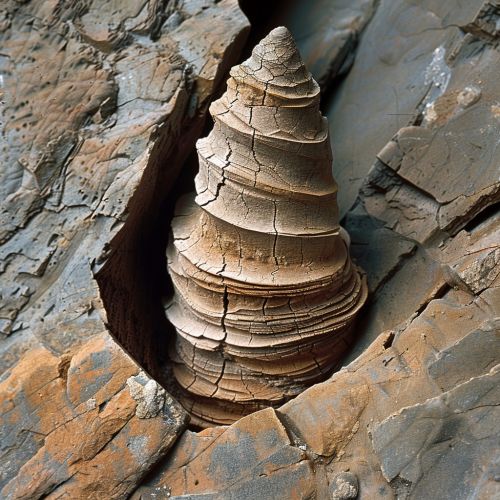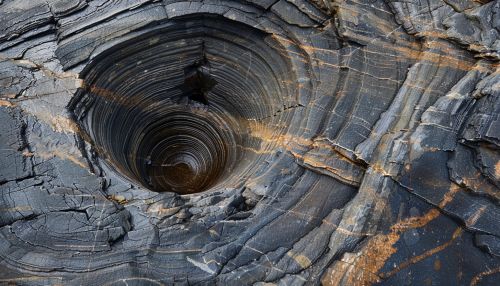Shatter cone
Introduction
A shatter cone is a distinctive, striated conical structure that forms in rocks subjected to the extreme pressures and shock waves generated by a meteorite impact. These geological features are critical indicators of impact events and are often used to confirm the presence of an impact structure, or astrobleme. Shatter cones are unique because they are not formed by any other known geological process, making them invaluable to the field of impact geology.
Formation and Characteristics
Shatter cones are formed when a high-velocity impact generates shock waves that travel through the target rock. These shock waves create a complex pattern of fractures, resulting in the characteristic conical shape. The apex of the cone typically points towards the source of the impact. Shatter cones can vary in size from a few centimeters to several meters in length.
The striations on shatter cones are known as "horsetail" patterns and are a result of the propagation of shock waves through the rock. These patterns are typically oriented parallel to the direction of the shock wave propagation. The surface of a shatter cone is often smooth, with a glossy appearance, due to the intense pressure and heat generated during the impact event.


Geological Context
Shatter cones are typically found in the central uplift or the surrounding area of an impact crater. The central uplift is a region of elevated rock that forms in the center of a crater due to the rebound of the Earth's crust following the impact. Shatter cones can also be found in the breccia and other impact-related deposits that form around the crater.
The presence of shatter cones is often used to confirm the impact origin of a geological structure. This is because shatter cones are not formed by volcanic activity, tectonic processes, or any other known geological phenomena. Therefore, their presence is a definitive indicator of an impact event.
Identification and Analysis
The identification of shatter cones involves examining the rock for the characteristic conical shape and striated surface. Geologists often use a hand lens or microscope to study the fine details of the striations. The orientation and distribution of shatter cones can provide valuable information about the direction and magnitude of the impact.
In addition to visual examination, geologists may use other analytical techniques to study shatter cones. These techniques include scanning electron microscopy (SEM), which can reveal the microstructural details of the striations, and X-ray diffraction (XRD), which can provide information about the mineralogical changes that occur during the formation of shatter cones.
Significance in Impact Studies
Shatter cones are crucial for the study of impact craters and the processes that form them. They provide direct evidence of the extreme pressures and shock waves generated by an impact event. By studying shatter cones, geologists can gain insights into the dynamics of impact cratering, including the energy and velocity of the impacting body, the properties of the target rock, and the subsequent geological processes that modify the crater.
Shatter cones also play a vital role in the identification of ancient and eroded impact structures. In many cases, the original crater may be heavily eroded or buried beneath younger sediments, making it difficult to recognize. The discovery of shatter cones in such areas can provide definitive evidence of an impact origin, even when the crater itself is no longer visible.
Examples of Shatter Cone Locations
Shatter cones have been found in numerous impact structures around the world. Some notable examples include:
- The Sudbury Basin in Ontario, Canada, which is one of the largest and oldest known impact structures.
- The Vredefort Crater in South Africa, which is the largest confirmed impact structure on Earth.
- The Chesapeake Bay Impact Crater in the United States, which is buried beneath the sediments of the Chesapeake Bay.
These locations provide valuable opportunities for studying shatter cones and the impact processes that form them. Each site offers unique insights into the geological history and the effects of large-scale impact events on the Earth's crust.
